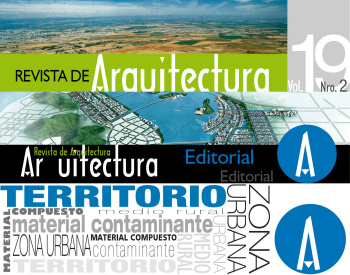

This work is licensed under a Creative Commons Attribution-NonCommercial 4.0 International License.
Revista de Arquitectura is an open access journal. More information...
Authors retain copyright and grant to the Revista de Arquitectura the right of first publication, which will be simultaneously subject to the Creative Commons (CC) BY-NC license.
Authors will sign a non-exclusive distribution license for the published version of the article by completing (RevArq FP03 Permission to Reproduce).
Self-archiving will comply with SHERPA/RoMEO guidelines and the Green classification.
To see in detail these guidelines, please consult...
Abstract
Research and innovation are considered to be the basis for dissemination to the scientific community, this is the premise that should govern academic communities, associated with ancestral wisdom. This leads to the study and implementation of what has been discussed in forums and congresses in relation to current issues, such as rural-to-urban migrations, sustainability, and cutting-edge technologies that provide the most appropriate use of resources, combined with thoughts about territorial development in order to metabolize sustainable cities that are, in turn, interwoven, in all aspects, with the natural environment. This also provides academic spaces, open to the scientific community, to address issues that consider and analyze the future of cities, and reflect on future interests in terms of technology, environment, and sustainability.

References
Aguado, M. (2015). Migración urbana en un planeta abarrotado. IberoaméRica social: Revista-Red de estudios sociales, (IV), 26-27. Recuperado de: http://iberoamericasocial.com/ojs/index.php/IS/article/view/87
Eligio-Triana, C. (2012). ¿Hacia dónde va la producción escrita en arquitectura? Revista de Arquitectura, 14 (1), 3. Recuperado de http://editorial.ucatolica.edu.co/ojsucatolica/revistas_ucatolica/index.php/RevArq/article/view/720
Gomez-Baggethun, E. (2016). Prólogo. En Naturaleza urbana: plataforma de experiencias. Bogotá: Instituto de Investigación de Recusos Biológicos Alexander von Humboldt.
ISA Internationales Stadtbauatelier (2013, 19 de marzo). Ciudad inteligente Nansha en Guangzhou, República Popular China [imagen digital]. Recuperado de: https://es.wikipedia.org/wiki/Archivo:Smart_City_Nansha.jpg#/media/File:Smart_City_Nansha.jpg
La ciudad viva (2009, 10 de noviembre). Territorio disperso en Jaén [Fotografía]. Recuperado de: https://es.wikipedia.org/wiki/Archivo:Territorio_disperso.jpg#/media/File:Territorio_disperso.jpg
Rozo Montaña, N. (1999). Editorial. Revista de Arquitectura, 1 (1), 1. Recuperado de: http://editorial.ucatolica.edu.co/ojsucatolica/revistasucatolica/index.php/RevArq/article/view/972/1029
Pomerantz, M., Pon, B., Hashem , A. y Sheng-Chieh, C. (2000). The effect of pavements' temperatures on air temperatures in large cities. Berkeley: Laurence Berkeley National Laboratory.
Riva, E. (s. f.). Eco ambientalmente sostenible [Ilustración]. Recuperado de: https://pixa-bay.com/es/eco-ambientalmente-sostenible-1976741/
Vitruvio (siglo 15 a. C. [1973]). De architectura (vol. II). Madrid: Ediciones de Arte y Bibliografía.
































